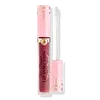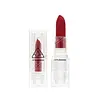What's inside
What's inside
 Key Ingredients
Key Ingredients

 Benefits
Benefits

 Concerns
Concerns

 Ingredients Side-by-side
Ingredients Side-by-side

Isododecane
EmollientHydrogenated Polyisobutene
EmollientPolyethylene
AbrasiveDiisostearyl Malate
EmollientDimethicone
EmollientBis-Diglyceryl Polyacyladipate-2
EmollientSynthetic Fluorphlogopite
C18-36 Acid Triglyceride
EmollientDisteardimonium Hectorite
StabilisingDimethicone/Vinyl Dimethicone Crosspolymer
Skin ConditioningSimmondsia Chinensis Seed Oil
EmollientEthylene/Propylene/Styrene Copolymer
Vanillyl Butyl Ether
MaskingPunica Granatum Flower Extract
Skin ConditioningPolyglyceryl-3 Diisostearate
EmulsifyingRosa Canina Fruit Extract
AstringentSilica
AbrasivePropylene Carbonate
SolventButylene/Ethylene/Styrene Copolymer
Parfum
MaskingPentaerythrityl Tetra-Di-T-Butyl Hydroxyhydrocinnamate
AntioxidantBHT
AntioxidantCI 77891
Cosmetic ColorantCI 77491
Cosmetic ColorantCI 77492
Cosmetic ColorantCI 77499
Cosmetic ColorantCI 15850
Cosmetic ColorantCI 45410
Cosmetic ColorantCI 19140
Cosmetic ColorantCI 15985
Cosmetic ColorantIsododecane, Hydrogenated Polyisobutene, Polyethylene, Diisostearyl Malate, Dimethicone, Bis-Diglyceryl Polyacyladipate-2, Synthetic Fluorphlogopite, C18-36 Acid Triglyceride, Disteardimonium Hectorite, Dimethicone/Vinyl Dimethicone Crosspolymer, Simmondsia Chinensis Seed Oil, Ethylene/Propylene/Styrene Copolymer, Vanillyl Butyl Ether, Punica Granatum Flower Extract, Polyglyceryl-3 Diisostearate, Rosa Canina Fruit Extract, Silica, Propylene Carbonate, Butylene/Ethylene/Styrene Copolymer, Parfum, Pentaerythrityl Tetra-Di-T-Butyl Hydroxyhydrocinnamate, BHT, CI 77891, CI 77491, CI 77492, CI 77499, CI 15850, CI 45410, CI 19140, CI 15985
Dimethicone
EmollientIsoamyl Laurate
EmollientDiisostearyl Malate
EmollientCI 77891
Cosmetic ColorantDiphenyl Dimethicone/Vinyl Diphenyl Dimethicone/Silsesquioxane Crosspolymer
Vinyl Dimethicone/Methicone Silsesquioxane Crosspolymer
Synthetic Wax
AbrasiveIsoeicosane
EmollientBis-Diglyceryl Polyacyladipate-2
EmollientHydrogenated Polyisobutene
EmollientSilica
AbrasivePolyglyceryl-2 Triisostearate
EmulsifyingEuphorbia Cerifera Wax
Diglyceryl Sebacate/Isopalmitate
EmollientPolyethylene
AbrasiveCI 77491
Cosmetic ColorantPhytosteryl Macadamiate
Skin ConditioningDimethicone/Vinyl Dimethicone Crosspolymer
Skin ConditioningCopernicia Cerifera Wax
Ethylhexyl Hydroxystearate
EmollientSorbitan Isostearate
EmulsifyingCaprylic/Capric Triglyceride
MaskingDimethicone Crosspolymer
Emulsion StabilisingPolyhydroxystearic Acid
EmulsifyingTriethoxycaprylylsilane
Ethylhexyl Palmitate
EmollientIsopropyl Myristate
EmollientIsostearic Acid
CleansingLecithin
EmollientStearalkonium Hectorite
Gel FormingPolyglyceryl-2 Diisostearate
EmulsifyingPolyglyceryl-3 Polyricinoleate
EmulsifyingPropylene Carbonate
SolventPentaerythrityl Tetra-Di-T-Butyl Hydroxyhydrocinnamate
AntioxidantCI 45410
Cosmetic ColorantCI 42090
Cosmetic ColorantCI 77492
Cosmetic ColorantCI 77499
Cosmetic ColorantDimethicone, Isoamyl Laurate, Diisostearyl Malate, CI 77891, Diphenyl Dimethicone/Vinyl Diphenyl Dimethicone/Silsesquioxane Crosspolymer, Vinyl Dimethicone/Methicone Silsesquioxane Crosspolymer, Synthetic Wax, Isoeicosane, Bis-Diglyceryl Polyacyladipate-2, Hydrogenated Polyisobutene, Silica, Polyglyceryl-2 Triisostearate, Euphorbia Cerifera Wax, Diglyceryl Sebacate/Isopalmitate, Polyethylene, CI 77491, Phytosteryl Macadamiate, Dimethicone/Vinyl Dimethicone Crosspolymer, Copernicia Cerifera Wax, Ethylhexyl Hydroxystearate, Sorbitan Isostearate, Caprylic/Capric Triglyceride, Dimethicone Crosspolymer, Polyhydroxystearic Acid, Triethoxycaprylylsilane, Ethylhexyl Palmitate, Isopropyl Myristate, Isostearic Acid, Lecithin, Stearalkonium Hectorite, Polyglyceryl-2 Diisostearate, Polyglyceryl-3 Polyricinoleate, Propylene Carbonate, Pentaerythrityl Tetra-Di-T-Butyl Hydroxyhydrocinnamate, CI 45410, CI 42090, CI 77492, CI 77499
Ingredients Explained
These ingredients are found in both products.
Ingredients higher up in an ingredient list are typically present in a larger amount.
This ingredient is lipid-based synthetic skin-conditioning agent derived from adipic acid and a mixture of fatty acids. It is often called a lanolin substitute.
As an emollient, it helps soften and hydrate the skin. Emollients create a barrier on the skin to trap moisture in.
Due to its fatty acid base, it may not be Malassezia folliculitis safe.
Learn more about Bis-Diglyceryl Polyacyladipate-2CI 45410 is a synthetic red-pigment and dye.
It often goes by both Red 28 or Red 27; manufacturers label both ingredients as CI 45410.
This dye is commonly found in makeup because it imparts a vivid color. Some types of this dye change color based on pH level and interaction with moisture:
Your skin has a natural pH of around 4.5 - 5.5.
According to the FDA, CI 45410 is not permitted for use in eye products.
Red 27 is a flourescein dye and commonly used as a fluorescent tracer in medicine.
Learn more about CI 45410Ci 77491 is also hydrated iron III oxide. It's sole purpose is to give a red/pink hue to products.
Iron III oxides are classified as inorganic chemicals for coloring.
Synthetically created Ci 77491 is considered safer than those naturally found. This is because the synthetically created version may contain less impurities. Iron oxides are generally non-toxic and non-allergenic.
Learn more about CI 77491Ci 77492 is also hydrated iron III oxide. It's sole purpose is to give a yellow hue to products.
Iron III oxides are classified as inorganic chemicals for coloring.
Synthetically created Ci 77492 is considered safer than those naturally found. This is because the synthetically created version may contain less impurities. Iron oxides are generally non-toxic and non-allergenic.
Learn more about CI 77492Ci 77499 is also hydrated iron III oxide. It is created from mixing red and black iron oxides. This helps give shades of darkness to a product.
Iron III oxides are classified as inorganic chemicals for coloring.
Ci 77891 is a white pigment from Titanium dioxide. It is naturally found in minerals such as rutile and ilmenite.
It's main function is to add a white color to cosmetics. It can also be mixed with other colors to create different shades.
Ci 77891 is commonly found in sunscreens due to its ability to block UV rays.
Learn more about CI 77891Diisostearyl Malate is an emollient and most often used in lip products. It comes from isostearyl alcohol, a fatty acid, and malic acid, an AHA.
As an emollient, Diisostearyl Malate helps create a thin film on your skin to trap moisture in. This helps keep your skin soft and smooth.
Dimethicone is a type of synthetic silicone created from natural materials such as quartz.
What it does:
Dimethicone comes in different viscosities:
Depending on the viscosity, dimethicone has different properties.
Ingredients lists don't always show which type is used, so we recommend reaching out to the brand if you have questions about the viscosity.
This ingredient is unlikely to cause irritation because it does not get absorbed into skin. However, people with silicone allergies should be careful about using this ingredient.
Note: Dimethicone may contribute to pilling. This is because it is not oil or water soluble, so pilling may occur when layered with products. When mixed with heavy oils in a formula, the outcome is also quite greasy.
Learn more about DimethiconeThis ingredient is a silicone used to improve the texture of products and absorb oil. It does not get absorbed into the skin.
Like other silicones, Dimethicone/Vinyl Dimethicone Crosspolymer helps condition the skin by creating a barrier. In this sense, it can act as an emollient and trap moisture in.
This ingredient is a type of elastomer.
Learn more about Dimethicone/Vinyl Dimethicone CrosspolymerHydrogenated Polyisobutene is a synthetic polymer. Polymers are compounds with high molecular weight. Hydrogenated Polyisobutene is an emollient and texture enhancer.
In one study, Hydrogenated Polyisobutene showed better skin hydration levels than Caprylic/Capric Triglyceride. As an emollient, it helps keep your skin soft and hydrated by trapping moisture in.
Hydrogenated Polyisobutene is often used as a mineral oil replacement.
Learn more about Hydrogenated PolyisobutenePentaerythrityl Tetra-Di-T-Butyl Hydroxyhydrocinnamate (long name, huh?) is a synthetic antioxidant.
It is used to help stabilize other antioxidants or prevent the color from changing in a product.
As an antioxidant, it helps fight free-radical molecules. Free-radical molecules are capable of damaging our cells and other genetic material. Thus, antioxidants may reduce the signs of aging.
This ingredient is oil-soluble.
Learn more about Pentaerythrityl Tetra-Di-T-Butyl HydroxyhydrocinnamatePolyethylene is a synthetic ingredient that helps the skin retain moisture. It is a polymer.
It is also typically used within product formulations to help bind solid ingredients together and thicken oil-based ingredients. When added to balms and emulsions, it helps increase the melting point temperature.
This ingredient is a solvent. It helps dissolve active ingredients and alter the texture of products.
Propylene Carbonate is commonly used in makeup and with clay, such as montmorillonite or bentonite.
Studies show this ingredient to be safe for cosmetics. When it is undiluted, it can cause skin irritation. (It is always diluted in skincare and makeup). This ingredient is water-soluble.
Propylene Carbonate is created from propylene glycol and carbonic acid.
Learn more about Propylene CarbonateSilica, also known as silicon dioxide, is a naturally occurring mineral. It is used as a fine, spherical, and porous powder in cosmetics.
Though it has exfoliant properties, the function of silica varies depending on the product.
The unique structure of silica enhances the spreadability and adds smoothness, making it a great texture enhancer.
It is also used as an active carrier, emulsifier, and mattifier due to its ability to absorb excess oil.
In some products, tiny microneedles called spicules are made from silica or hydrolyzed sponge. When you rub them in, they lightly polish away dead skin layers and enhance the penetration of active ingredients.
Learn more about Silica